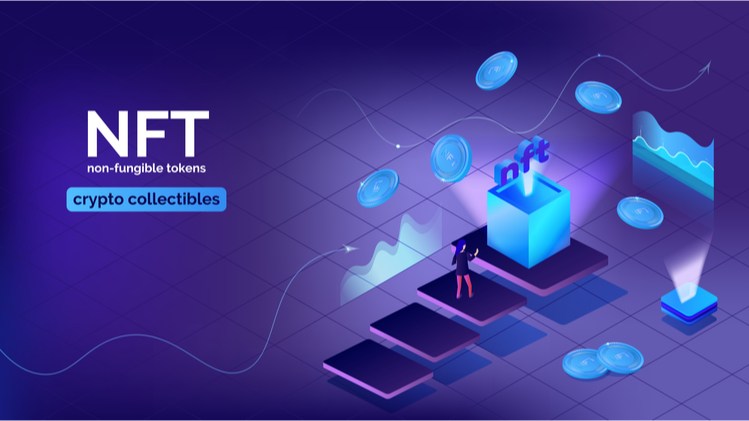The future is upon us. As a kid, I always heard about the chance of owning a digital version of a baseball card or piece of art as some futuristic phenomenon that would never happen in my lifetime. Wow – was I wrong. Over the last year or so I have followed the rise in popularity of non-fungible tokens or NFTs.
- NFTs are essentially virtual collectibles
- NFTs are fast becoming a billion dollar market
- It is unclear how the IRS will treat them for tax purposes
What is an NFT?
An NFT is a type of digital file created on a smart contract platform such as Ethereum using blockchain technology that represents a unique asset. An NFT can be an entirely digital asset or a tokenized version of real-world asset, such as the Mona Lisa. One of the core characteristics of an NFT is that it is not interchangeable. In other words, an NFT is not fungible. Whereas, fungible asset units are interchangeable, such as the U.S. dollar. You can trade one dollar for four quarters.
One of the main benefits of an owning an NFT, such as a digital sports highlight versus a physical asset, such as a baseball card or piece of artwork, is that each NFT is comprised of unique information that makes it both distinct from any other NFT and undoubtedly verifiable via the blockchain. Hence, selling fake NFTs becomes close to impossible because each NFT can be traced back to the original issuer using blockchain technology.
NFTs can be traded in online marketplaces, such as OpenSea. The price of NFTs varies, like any other asset, in response to market supply and demand. The value of an NFT is based on the concept of shared belief. Just like a precious metal, alt coins, vehicles, or watch, an NFT has value because people believe they do.
How Much Are NFTs Worth??
With many Americans stuck at home and with extra money to spend, NFTs have become immensely popular during the COVID-19 pandemic. For example, OpenSea, the largest marketplace for buying and selling NFTs, booked almost $90 million US worth of transactions in January 2021. That’s up from $8 million US the month before and just $1.5 million this time last year.
The NFT market is becoming hugely popular with gamers and crypto enthusiasts. For example, Digital artist Mike Winkelmann, better known by his online alias, Beeple, made headlines recently for selling the NFT of the 10-second video he created, to an investor for $67,000 US in 2020. The buyer, Miami-based art collector Pablo Rodriguez-Fraile, recently sold that NFT for the record price of $6.6 million dollars.
Related: IRS Issues New Guidance on NFTs in an IRA
How Are NFTs Taxed?
The question then becomes how should NFTs be taxed? In general, NFTs are considered capital assets. However, should an NFT be treated as a collectible for tax purposes? The Taxpayer Relief Act of 1997, while lowering the maximum capital gains rate on gains from the sale of most assets to 20%, left the maximum rate on gains from the sale of collectibles at 28%. For example, a sale of artwork by an investor is subject to the higher capital gains tax rate of 28%. So how does the IRS define what a collectible is?
Internal Revenue Code (“IRC”) Section 408(m), defined a collectible as:
- (A) any work of art,
- (B) any rug or antique,
- (C) any metal or gem,
- (D) any stamp or coin,
- (E) any alcoholic beverage, or
- (F) any other tangible personal property specified by the Secretary for purposes of this subsection.
Let’s take the example of art. IRC 408(m) is clear that “any” work of art should be treated as a collectible, but should that also include a digital, “non-tangible” version of art, such as an NFT? Unfortunately, there is no specific IRS guidance on this issue. IRS Notice 2014-21, which addresses the taxation of virtual currency, does not address the taxation of NFTs.
On one side, one can make the argument that “any” work of art, includes digital art or an NFT of the Mona Lisa, for example. However, on the other side, why does the IRS reference “any other tangible personal property” when describing future assets the IRS could treat as collectibles for tax purposes. Clearly an NFT is not a tangible personal property. A tangible personal property is a tax term describing personal property that can be physically relocated, such as furniture and office equipment. A digital image of a slam dunk by NBA star Lebron James on an NFT recently sold for more than $208,000. Clearly the image is not physical tangible personal property, but is it still a work of art and, hence, a collectible? The answer could determine if a retirement account, such as a Self-Directed IRA or 401(k) plan can purchase NFTs.
IRC 408(m) is clear that a retirement account may not invest in any “collectible” as outlined in the code section. Accordingly, if an NFT is treated as a collectible, then it would not be permitted to be purchased or held in a retirement account. Unfortunately, not all NFTs fit squarely into a type of collectable outlined in IRC 408(m). Just recently, Jack Dorsey, the founder of Twitter, appears to be offering to sell the very first Twitter tweet as an NFT. Would the purchase of that NFT be deemed a collectible? Is it a work of art? Does it matter that the tweet it is not tangible personal property?
Read More: Crypto Staking in an IRA
Conclusion
The NFT market is very exciting and potential enormous. Think about this. You can go to the Modern Museum of Art to take a picture of Vincent van Gogh’s Starry Night and you can have the picture. But, it has no value because you do not own the history of the artwork. The main benefit of NFTs is the certificate of provenance and authenticity of the artwork. Or consider this. With NBA Top Shot, an online company backed by the NBA, that allows users to acquire a collection of digital basketball highlights, instead of buying a pack of physical sports cards, investors can buy NFTs of videos of memorable on-court moments that you “officially” own.
For anyone considering investing in NFTs with retirement funds, the most prudent approach is to proceed with caution. With no formal IRS guidance on whether NFTs are collectibles and, thus, not permitted to be owned by retirement accounts, or some other form of intangible digital assets, for the time being, it may be wise to consider using personal funds to make NFT investments. While you may not be able to invest in an NFT in your IRA, you can still invest in a wide variety of alternative investments in your IRA.
Hopefully, we hear something in the near future from the IRS regarding non-fungible tokens. Until then, play it safe, just in case. If we become certain that they are allowed, IRA Financial will be the first to let you know…and invest!
Read More:








